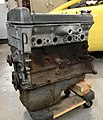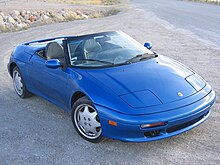Lotus Elan
Lotus Elan was the sales name for two different sports cars from the manufacturer Lotus Cars . The first Elan with a front-engine and rear-wheel drive was built from 1962 to 1975 and was available as a convertible and coupé . The second Elan with transverse engine and front-wheel drive was only offered as a convertible from 1989 to 1995.
Elan type 26, 36, 45, 50 (1962–1975)
development
The Elan was introduced in 1962 as a roadster (type 26), from 1963 there was a hardtop option and from 1965 a coupé (type 36). The two-seater Elan replaced the elegant but not durable and expensive to produce Lotus Elite . In 1966 the roadster version was replaced by a convertible ("Drop Head Coupe", Type 45), and from 1967, the Elan +2 (Type 50), a version with an extended wheelbase and two seats in the rear. The Elan was the first Lotus production sports car with a steel frame and body made of fiberglass-reinforced plastic . The vehicle has a curb weight of 680 kg. Early versions of the Elan were also available as a kit to save the tax on finished vehicles. The Elan was technically advanced: engine with two overhead camshafts, chassis with four disc brakes and independent wheel suspension. The Lotus-Ford twin cam engine was based on Ford's Kent engine , with an aluminum cylinder head designed by Lotus with two overhead camshafts. This Lotus-Ford four-cylinder engine was used in a number of other Lotus sports and racing cars. Initially the Elan was delivered with an engine with 1499 cm³ and 101 hp, but the displacement was soon increased to 1558 cm³. Since Lotus urgently needed the smaller engine for racing in order to be able to start in the 1.5-liter class, the owners of Elan received the new larger engine with this displacement free of charge, Lotus then kept the smaller one. Elan with the smaller engine are very rare today.
Technical innovation
Instead of a susceptible self-supporting plastic body, like the Elite, the Elan has a separate vehicle frame made of steel with a body made of glass fiber reinforced plastic (GRP). The X-shaped central tube frame weighs 34 kg / 75 lb and carries the engine and transmission between its front ends, while Ford final drives with Lotus housings and rear suspension sit at the rear end. The seats are located deep in the GRP shell on both sides of the central tube. The rear suspension struts are attached to tall, thin brackets on the frame. The rubber joints of the drive shafts, in conjunction with the soft suspension, could cause the car to rock if the accelerator was accelerated irregularly.
Axle drive from a Ford banjo axle
Rear hub with Chapman strut
The new Lotus engine with the engine block of the Ford Kent engine from the Ford Cortina had 5 crankshaft bearings. The aluminum cylinder head was further developed from the 1950s from a head with two overhead camshafts, hemispherical combustion chambers and two valves per cylinder. The new engine became an important pillar of the company for over ten years, it also worked in three Ford models: the Lotus Cortina Mk 1, the Lotus Cortina Mk 2 and the Escort Twin-Cam.
Market success
The new Elan was an immediate success. It was small, light, fast and economical, and it also offered agile handling, excellent road holding and a high level of driving comfort. Although the car was redesigned and improved over time, it was notoriously unreliable, especially when it came to the electrical system. However, these deficiencies have been eliminated over the years. The best Elan models were the powerful Sprint Big-Valve from 1971 to 1973, especially the carefully crafted closed coupés. In retrospect, the models with the Stromberg carburettor were probably the worst choice, but the drive was still a generation ahead of its competition in terms of handling and technology. In a little over ten years, 9,659 copies were produced.
The Plus 2 had the same engines, transmissions and suspension systems as the Elan, but a different chassis and body. The chassis also had a central tubular structure, but 31 cm more wheelbase and a wider track. Every Elan Plus 2 had a fixed coupe roof, but private manufacturers also built a few folding roof coupes.
Just like the smaller Elan, the Plus 2 was very fast and surprisingly economical, and its roadholding left nothing to be desired. In addition, it offered more space and was more practical than the two-seater. Since it was heavier than the two-seater, the Plus 2 could not accelerate as quickly, so Lotus built in Big Valve engines from 1971 and a new five-speed gearbox from 1972. In 1974 the Plus 2 was taken off the market and replaced by the larger and more expensive Elite of the second generation. A total of 4798 Elan Plus 2 had been built.
variants
The Lotus Elan S2 was technically similar to the S1, but had better front brakes, a wooden dashboard and, if desired, wheels with central locking.
The Lotus Elan S3 (1965–1968) came either as a closed coupé and with an SE engine (85 kW) and with a frame around the side windows in the open sport version.
The Lotus Elan S4 (1968–1971) had been redesigned and had wider fenders, a curved bonnet and a modified dashboard. Top speed 177 km / h.
The Lotus Elan Sprint (1971-1973) had the big valve engine with 93 kW and an improved drive train. Nevertheless, the top speed only rose to 189 km / h.
The Lotus Elan Plus 2S (1969–1971) was better equipped than the basic version. It was not available as a kit.
The Lotus Elan Plus 2S 130 (1971-1974) had a big valve engine with 93 kW.
The Lotus Elan Plus 2S 130/5 (1972–1974) had the 93 kW engine and a five-speed gearbox. He was 193 km / h fast.
Derivatives
Hexagon engine, a Lotus dealer from the London district of Highgate , developed in 1971 a shooting brake based on the Elan. The car had large glass surfaces behind the B-pillar and a steep rear end. The rear window served as a trunk lid. The conversion cost was £ 595, one third of the price of a new car. Hexagon only produced two copies of the station wagon.
Elan type M100 (1989–1992)
The second Lotus Elan (M100) was a front-wheel drive roadster and appeared in 1989. After Colin Chapman's death, the company was almost bankrupt. By the mid-1980s, the company was in big trouble again until General Motors took over Lotus in 1986. The first Elan project was the M90 with rear-wheel drive and Toyota engine in 1982, but it was dropped in 1985 in favor of the X100, also designed with the help of Toyota. After the takeover by GM, this project was also ended; instead, development of the new M100 began in 1986.
The actual “new Elan” was then a car with front-wheel drive (for the first time with Lotus) and a 1.6-liter engine with 16 valves from Isuzu with a five-speed gearbox. This drive unit was supplied by the Japanese company Isuzu , in which GM was involved. The new car not only had front-wheel drive, but also a new subframe for the front suspension, which was thus isolated from the base, i.e. the central tubular frame and the steel-reinforced floor pan. The front suspension was designed with double wishbones , the rear wheels were also guided on double wishbones like the Excel , the lower link was trapezoidal with two bearings on the wheel and two on the frame, the upper one was a simple rod. The engineers had left room for a possible all-wheel drive, but this was never realized.
The car was short, wide, stocky and stocky, with a huge windshield and a narrow two-seater body. When it was opened, the convertible top disappeared into a corresponding cavity behind the seats. The car was offered with an injection engine (95 kW) or a turbocharger (119 kW). Lotus’s sales forecast was soon confirmed by the sales figures. The Elan was easy to control and offered a lot of quality for the money, the SE cost 20,325 pounds when it went on sale in 1990 - in comparison, you paid 26,400 pounds for an Excel. The performance of the Elan received a lot of praise, an SE accelerated from 0 to 100 km / h in 6.5 s and from 0 to 160 km / h in just 17.5 s. Lotus was full of hope that the Elan would ensure another expansion, although the start of the front-wheel drive was sluggish. Sales in the US were also worse than expected, and the parent company GM then stopped production in 1992.
With the new owner Romano Artioli, the S2 was launched from the remaining stocks. The series, limited to 800 units with some improvements in detail, expired in 1995. The car was offered exclusively with the turbo engine and was one of the first series manufacturers to come onto the market with 16-inch wheels with 45 mm cross-sectional tires.
Kia Elan 1996-1999
After the end of production, the production facilities were sold to the Korean manufacturer Kia Motors . He built the model between 1996 and 1999 as the Kia Elan. The shape remained almost the same except for the taillights. The 1.6-liter Isuzu engine was replaced by a 1.8-liter 113 kW (151 hp) engine from Kia. The model name Galloper Elan was used for export to Arab markets .
Kia Elan at Retro Classics 2018
literature
- G. Arnold: The Lotus Elan and Plus Two Buyers Guide 1962-1975 . Club Lotus, 19981.
- RM Clarke: Lotus Elan Collection No.2 1963-1972 . Brooklands Books. ISBN 0-907073-68-9 .
- James Elliot: L ots O f T hrills, U sually S ensational . History of the model series on the occasion of the 50th anniversary in: Classic & Sports Car, issue 7/2012, p. 102 ff.
- C. Harvey: Lotus: The Elite, Elan, Europe . Oxford Illustrated Press, 1982, ISBN 0-902280-85-6 .
- Lotus Cars Limited. 1974. Lotus Elan +2 Workshop Manual . Lotus Cars.
- Robin Read: Colin Chapman's Lotus (The early years, the Elite, and origins of the Elan) . Haynes / Foulis, 1989, ISBN 0-85429-703-0 .
- W. Taylor: The Lotus Book, a complete History of Lotus Cars, 50th Anniversary Special . Coterie Press Limited, 1998, ISBN 1-902351-00-2 .
- D. Wherret: Lotus Elan . Osprey, 1993, ISBN 1-85532-377-X .
- Miles Wilkins: Lotus Twin-Cam Engine . Motorbooks, 2003, ISBN 978-0-7603-1692-4 .
Individual evidence
- ↑ http://www.lotuselan.net/publish/article_341.shtml
- ↑ Lotus Elan S4 Coupé - the unrivaled lightness of being Article about all variants of the Lotus Elan with historical quotes from 1968 on Zwischengas.com (last accessed September 27, 2016)
- ↑ Classic and Sports Car, issue 7/2012, p. 111.
- ↑ http://www.gglotus.org/ggtech/m100-lcu-manual/m100lcu.htm
Web links













